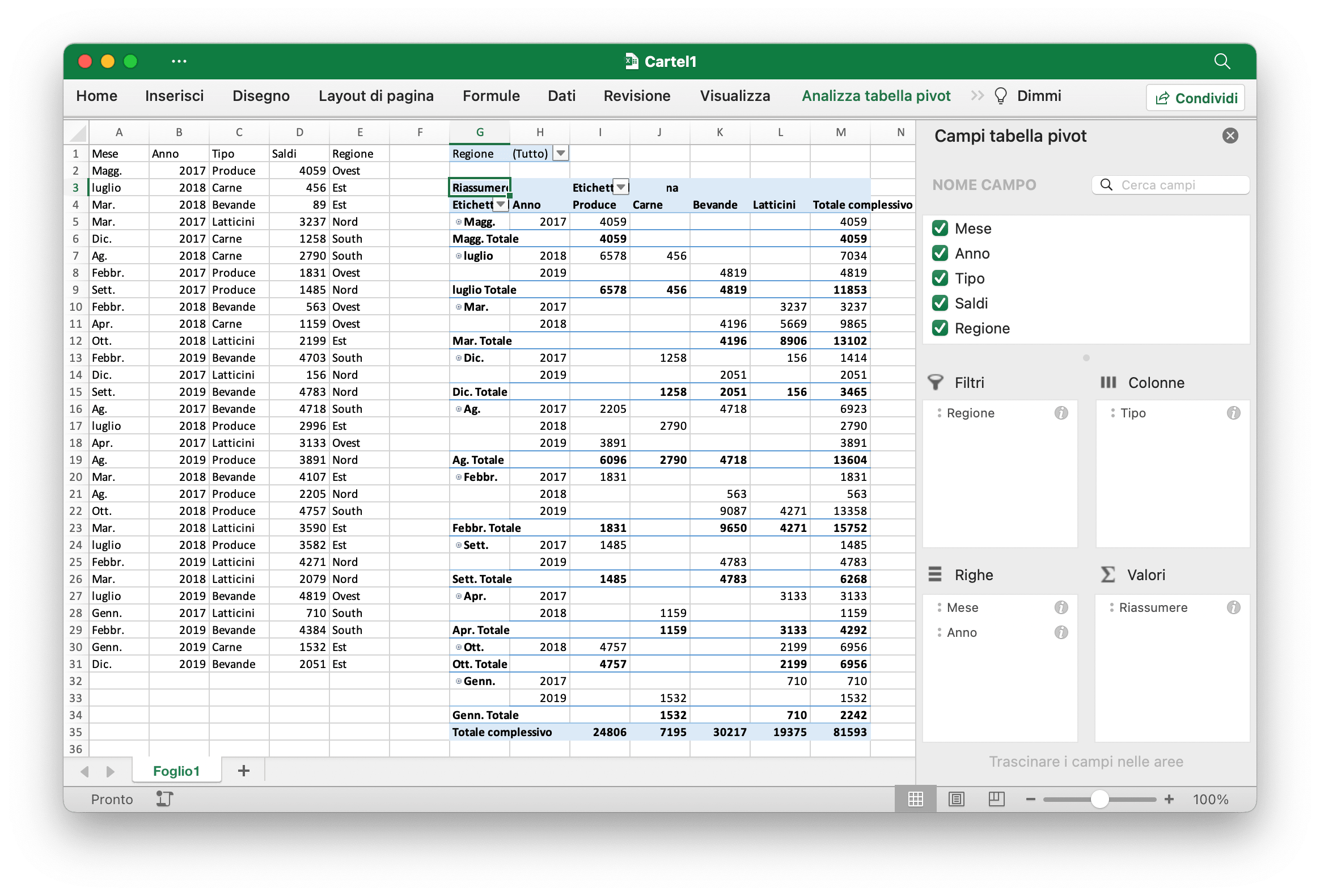Tabella pivot
Una tabella pivot è una tabella di statistiche che riepiloga i dati di una tabella più ampia (ad esempio da un database, un foglio di calcolo o un programma di business intelligence). Questo riepilogo potrebbe includere somme, medie o altre statistiche, che la tabella pivot raggruppa in modo significativo.
PivotTableOptions mappa direttamente le impostazioni di formato della tabella pivot.
type PivotTableOptions struct {
DataRange string
PivotTableRange string
Name string
Rows []PivotTableField
Columns []PivotTableField
Data []PivotTableField
Filter []PivotTableField
RowGrandTotals bool
ColGrandTotals bool
ShowDrill bool
UseAutoFormatting bool
PageOverThenDown bool
MergeItem bool
ClassicLayout bool
CompactData bool
ShowError bool
ShowRowHeaders bool
ShowColHeaders bool
ShowRowStripes bool
ShowColStripes bool
ShowLastColumn bool
FieldPrintTitles bool
ItemPrintTitles bool
PivotTableStyleName string
// contiene campi filtrati o non esportati
}
PivotTableStyleName: i nomi degli stili di tabella pivot integrati:
PivotStyleLight1 - PivotStyleLight28
PivotStyleMedium1 - PivotStyleMedium28
PivotStyleDark1 - PivotStyleDark28
PivotTableField mappa direttamente le impostazioni del campo della tabella pivot.
type PivotTableField struct {
Compact bool
Data string
Name string
Outline bool
ShowAll bool
InsertBlankRow bool
Subtotal string
DefaultSubtotal bool
NumFmt int
}
Subtotal specifica la funzione di aggregazione che si applica a questo campo dati. Il valore predefinito è Sum. I possibili valori per questo attributo sono:
| Valore facoltativo |
|---|
| Average |
| Count |
| CountNums |
| Max |
| Min |
| Product |
| StdDev |
| StdDevp |
| Sum |
| Var |
| Varp |
Name specifica il nome del campo dati. Nel nome del campo dati sono consentiti al massimo 255 caratteri, i caratteri in eccesso verranno troncati.
Crea tabella pivot
func (f *File) AddPivotTable(opts *PivotTableOptions) error
AddPivotTable fornisce il metodo per aggiungere una tabella pivot in base alle opzioni della tabella pivot.
Ad esempio, crea una tabella pivot nell'area Foglio1!$G$2:$M$34 con la regione Foglio1!$A$1:$E$31 come origine dati, riepiloga per somma per le vendite:

package main
import (
"fmt"
"math/rand"
"github.com/xuri/excelize/v2"
)
func main() {
f := excelize.NewFile()
defer func() {
if err := f.Close(); err != nil {
fmt.Println(err)
}
}()
if err := f.SetSheetName("Sheet1", "Foglio1"); err != nil {
fmt.Println(err)
return
}
// Creare alcuni dati in un foglio
month := []string{"Genn.", "Febbr.", "Mar.", "Apr.", "Magg.",
"Giugno", "luglio", "Ag.", "Sett.", "Ott.", "Nov.", "Dic."}
year := []int{2017, 2018, 2019}
types := []string{"Carne", "Latticini", "Bevande", "Produrre"}
region := []string{"Est", "Ovest", "Nord", "Sud"}
f.SetSheetRow("Foglio1", "A1", &[]string{"Mese", "Anno", "Tipo", "Saldi", "Regione"})
for row := 2; row < 32; row++ {
f.SetCellValue("Foglio1", fmt.Sprintf("A%d", row), month[rand.Intn(12)])
f.SetCellValue("Foglio1", fmt.Sprintf("B%d", row), year[rand.Intn(3)])
f.SetCellValue("Foglio1", fmt.Sprintf("C%d", row), types[rand.Intn(4)])
f.SetCellValue("Foglio1", fmt.Sprintf("D%d", row), rand.Intn(5000))
f.SetCellValue("Foglio1", fmt.Sprintf("E%d", row), region[rand.Intn(4)])
}
if err := f.AddPivotTable(&excelize.PivotTableOptions{
DataRange: "Foglio1!A1:E31",
PivotTableRange: "Foglio1!G2:M34",
Rows: []excelize.PivotTableField{
{Data: "Mese", DefaultSubtotal: true}, {Data: "Anno"}},
Filter: []excelize.PivotTableField{
{Data: "Regione"}},
Columns: []excelize.PivotTableField{
{Data: "Tipo", DefaultSubtotal: true}},
Data: []excelize.PivotTableField{
{Data: "Saldi", Name: "Riassumere", Subtotal: "Sum"}},
RowGrandTotals: true,
ColGrandTotals: true,
ShowDrill: true,
ShowRowHeaders: true,
ShowColHeaders: true,
ShowLastColumn: true,
}); err != nil {
fmt.Println(err)
return
}
if err := f.SaveAs("Cartel1.xlsx"); err != nil {
fmt.Println(err)
}
}
Ottieni tabelle pivot
func (f *File) GetPivotTables(sheet string) ([]PivotTableOptions, error)
GetPivotTables restituisce tutte le definizioni di tabella pivot in un foglio di lavoro in base al nome del foglio di lavoro specificato.
Elimina la tabella pivot
func (f *File) DeletePivotTable(sheet, name string) error
DeletePivotTable elimina una tabella pivot fornendo il nome del foglio di lavoro e il nome della tabella pivot. Tieni presente che questa funzione non pulisce i valori delle celle nell'intervallo della tabella pivot.